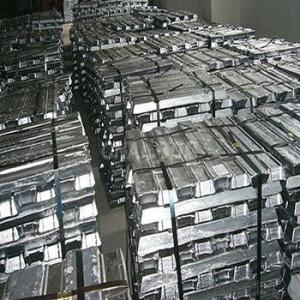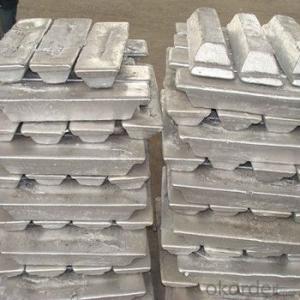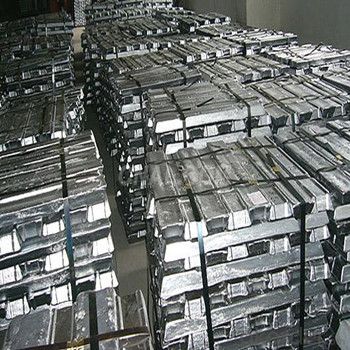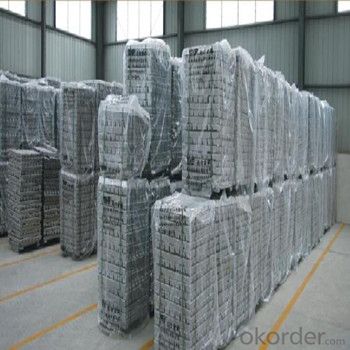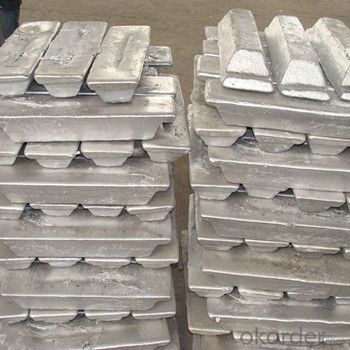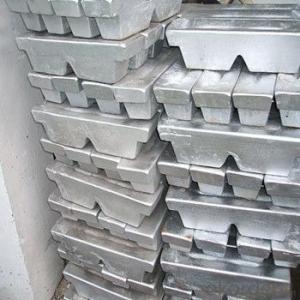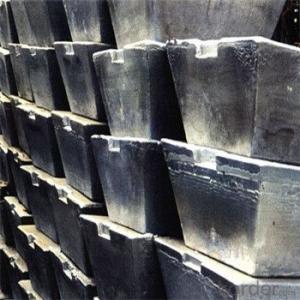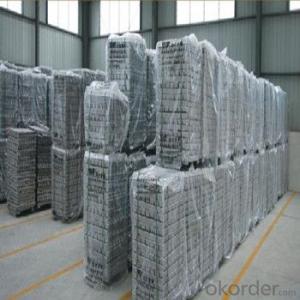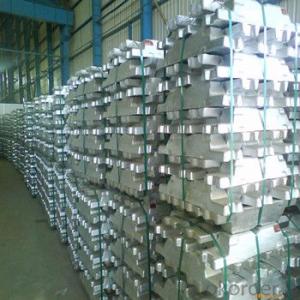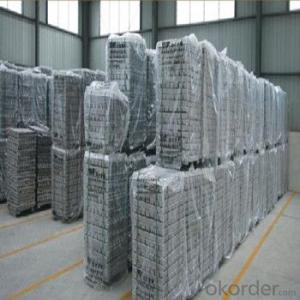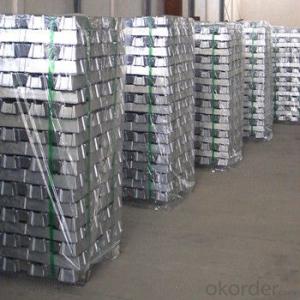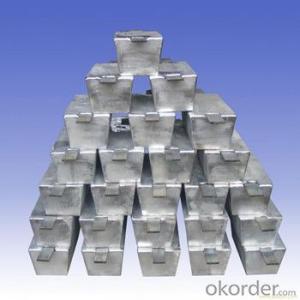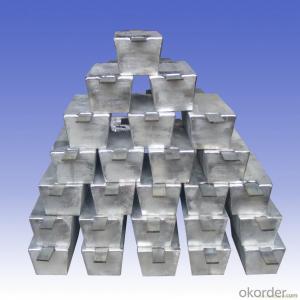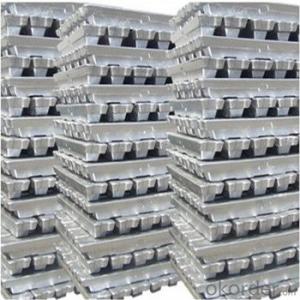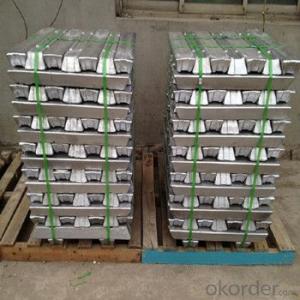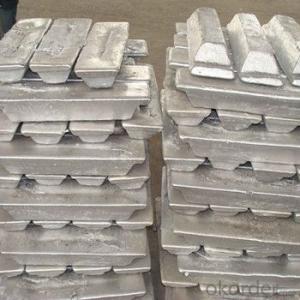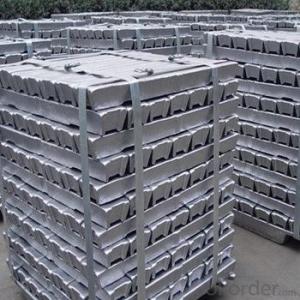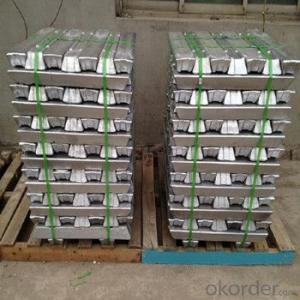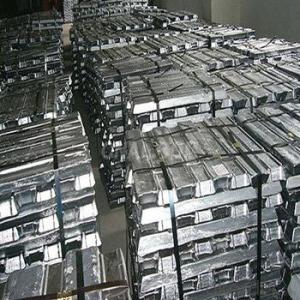Aluminium Ingot 99.7% Pure /Primary Aluminium Ingots Good Quality
- Loading Port:
- China main port
- Payment Terms:
- TT OR LC
- Min Order Qty:
- 1000 m.t.
- Supply Capability:
- 10000 m.t./month
OKorder Service Pledge
OKorder Financial Service
You Might Also Like
Pure Aluminum Ingot Used for Industry
1.Structure of Aluminum Ingot Description
A material that has been cast into a shape in order to be transported and processed easier than in an unprocessed form. An ingot is typically rectangular in shape, which allows it to be stacked. Ingots are most commonly associated with metals, with ingots of gold held in the vaults of banks and brokerages being popular images.
2.Main Features of the Aluminum Ingot
•High Purity
•High strength
•Fast melting
•Best price
•Good after-service
3. Aluminum Ingot Images


4. Aluminum Ingot Specification
Grade | Chemical Composition % | |||||||||
Al≥ | impurities ≤ | |||||||||
Si | Fe | Cu | Ga | Mg | Zn | Mn | others | Sum | ||
Al99.9 | 99.90 | 0.50 | 0.07 | 0.005 | 0.02 | 0.01 | 0.025 | - | 0.010 | 0.10 |
Al99.85 | 99.85 | 0.80 | 0.12 | 0.005 | 0.03 | 0.02 | 0.030 | - | 0.015 | 0.15 |
Al99.7 | 99.70 | 0.10 | 0.20 | 0.010 | 0.03 | 0.02 | 0.030 | - | 0.030 | 0.30 |
Al99.6 | 99.60 | 0.16 | 0.25 | 0.010 | 0.03 | 0.03 | 0.030 | - | 0.030 | 0.40 |
Al99.5 | 99.50 | 0.22 | 0.30 | 0.020 | 0.03 | 0.05 | 0.050 | - | 0.030 | 0.50 |
Al99.00 | 99.00 | 0.42 | 0.50 | 0.020 | 0.03 | 0.05 | 0.050 | - | 0.050 | 1.00 |
5.FAQ of Aluminum Ingot
We have organized several common questions for our clients,may help you sincerely:
①How about your company?
A world class manufacturer & supplier of castings forging in carbon steel and alloy steel,is one of the large-scale professional investment casting production bases in China,consisting of both casting foundry forging and machining factory. Annually more than 8000 tons Precision casting and forging parts are exported to markets in Europe,America and Japan. OEM casting and forging service available according to customer’s requirements.
②How to guarantee the quality of the products?
We have established the international advanced quality management system,every link from raw material to final product we have strict quality test;We resolutely put an end to unqualified products flowing into the market. At the same time, we will provide necessary follow-up service assurance.
③How long can we receive the product after purchase?
In the purchase of product within three working days, We will arrange the factory delivery as soon as possible. The pecific time of receiving is related to the state and position of customers.Commonly 7 to 10 working days can be served.
- Q: How is aluminium powder made into aluminium ingot?
- Usually out of the aluminum mill are aluminum ingots. Aluminum smelters are made from aluminium oxide and processed into aluminium ingots for sale.
- Q: What industries use aluminum ingots?
- Aluminum ingots are utilized by several industries due to their versatile properties and wide range of applications. Major industries heavily reliant on aluminum ingots include: 1. The automotive industry utilizes aluminum ingots to manufacture engine blocks, wheels, frames, and body panels. Aluminum's lightweight nature, corrosion resistance, and excellent thermal conductivity make it a preferred choice for improving fuel efficiency and reducing vehicle weight. 2. In the aerospace industry, aluminum ingots are extensively used to manufacture aircraft structures, wings, fuselage panels, and other components. Aluminum's high strength-to-weight ratio is ideal for building lightweight aircraft capable of withstanding the stresses of flight. 3. The construction industry relies on aluminum ingots for applications like windows, doors, roofing, and cladding systems. Aluminum's corrosion resistance, durability, and aesthetic appeal make it a popular choice for modern architectural designs. 4. The packaging industry extensively uses aluminum ingots to produce aluminum foils, cans, containers, and closures. Aluminum's excellent barrier properties, lightness, and recyclability make it a preferred material for preserving and protecting perishable items. 5. The electrical industry heavily depends on aluminum ingots to manufacture power transmission cables, electrical conductors, and wiring systems. Aluminum's high electrical conductivity, low weight, and cost-effectiveness make it a suitable alternative to copper in many electrical applications. 6. The marine industry employs aluminum ingots for fabricating boat hulls, masts, decks, and various components. Aluminum's corrosion resistance, lightness, and durability make it a preferred choice for constructing vessels that can withstand harsh marine environments. 7. The consumer goods industry utilizes aluminum ingots to manufacture cookware, furniture, appliances, and electronic devices. Aluminum's thermal conductivity, non-toxicity, and recyclability make it a popular material for consumer goods. These examples demonstrate the heavy reliance of various industries on aluminum ingots. Due to its advantageous properties, aluminum is widely used in machinery, transportation, energy, and even art and design sectors.
- Q: How are aluminum ingots used in the production of architectural structures?
- Aluminum ingots are commonly used in the production of architectural structures due to their lightweight, durability, and corrosion resistance properties. These ingots are melted down and cast into various shapes, such as beams, columns, and panels, which form the structural framework of buildings. The versatility of aluminum allows for the creation of intricate designs and enables architects to push the boundaries of innovative and sustainable architecture. Moreover, aluminum ingots can be easily recycled, making them an environmentally friendly choice for construction projects.
- Q: What is the process for smelting aluminum ingots?
- Smelting aluminum ingots consists of several steps. To start, bauxite ore, which serves as the main aluminum source, is mined and refined to extract impurities. The refined bauxite is then converted into alumina using the Bayer process. Following that, a large electric furnace is utilized to combine the alumina with cryolite and other additives. This mixture is subjected to extremely high temperatures, reaching approximately 1,800 degrees Celsius. The intense heat causes the alumina to melt and separate into aluminum and oxygen. Subsequently, the molten aluminum is tapped from the furnace and transferred to either a holding furnace or a ladle. During this stage, it is common to alloy the aluminum with other metals to enhance its properties. Common alloying elements include magnesium, silicon, copper, and zinc. Once the desired alloy composition is attained, the molten aluminum is poured into molds to create ingots. These molds are typically constructed from steel and can vary in size and shape based on specific requirements. After the aluminum has solidified and cooled, the ingots are extracted from the molds and undergo further processes such as heat treatment or rolling to achieve the desired mechanical properties and shape. In summary, the smelting process of aluminum ingots encompasses mining and refining bauxite, converting it into alumina, melting the alumina to separate aluminum and oxygen, alloying the molten aluminum, pouring it into molds, and finally processing the solidified ingots to achieve the desired properties.
- Q: What is the average weight of an aluminum ingot?
- The size and shape of an aluminum ingot can cause its average weight to differ. Nonetheless, a widely adopted standard weight for aluminum ingots is approximately 22.7 kilograms or 50 pounds. This weight is frequently employed in the industry to facilitate measurement and transportation. It should be emphasized that the actual weight of an aluminum ingot may slightly differ due to factors like impurities or discrepancies in the manufacturing process.
- Q: How are aluminum ingots used in the production of decorative items?
- Aluminum ingots are commonly used in the production of decorative items due to their versatility and aesthetic appeal. These ingots, which are essentially blocks of solid aluminum, serve as the raw material in the manufacturing process. Firstly, aluminum ingots are melted down and molded into various shapes and sizes to create the desired decorative item. This melting process is typically done in a foundry using specialized equipment, such as furnaces or crucibles, to heat the ingots to their melting point. Once liquefied, the aluminum is poured into molds or cast into specific designs, allowing for the creation of intricate and unique decorative pieces. Additionally, aluminum ingots can be extruded or pressed to form different profiles or patterns. Extrusion involves forcing the molten aluminum through a shaped die to create long, continuous shapes like bars, tubes, or wires. Pressing, on the other hand, uses mechanical force to shape the aluminum into specific designs or patterns. These extruded or pressed aluminum profiles are then further processed and finished to achieve the desired decorative appearance. Moreover, aluminum ingots can be subjected to a variety of surface treatments, including polishing, anodizing, or powder coating, to enhance their visual appeal and durability. Polishing the aluminum surface can give it a shiny, reflective finish, while anodizing involves the formation of a protective oxide layer that can be dyed in different colors. Powder coating, on the other hand, involves applying a layer of dry powder to the aluminum surface, which is then heated to form a smooth, protective coating. Overall, aluminum ingots play a crucial role in the production of decorative items as they provide a versatile and malleable material that can be transformed into various shapes, sizes, and finishes. The use of aluminum ingots allows for the creation of visually appealing and durable decorative pieces that can be used in a wide range of applications, from furniture and lighting fixtures to architectural elements and household items.
- Q: Aluminum scrap and aluminum ingot in the intermediate frequency aluminum furnace, which is more energy saving?
- Better slag, but take good time
- Q: How are aluminum ingots used in the production of window frames?
- The production of window frames heavily relies on aluminum ingots, which play a crucial role. To begin with, these ingots are melted and shaped according to the specific requirements of the frames. The melting process involves heating the ingots in a furnace until they reach their melting point of approximately 660 degrees Celsius. Once the aluminum is molten, it is poured into molds designed to achieve the desired shape of the window frame. Afterward, the molten aluminum is left to cool and solidify, resulting in a solid frame made of aluminum. The choice of aluminum ingots for this process is due to their exceptional properties. Aluminum is not only lightweight but also sturdy and durable, making it an ideal material for window frame production. Additionally, its corrosion-resistant nature is particularly important for outdoor window frames exposed to diverse weather conditions. Once the aluminum frames have solidified, they undergo further processes to meet the specific requirements and design of each window frame. These processes may include cutting, shaping, and finishing, which often require the use of specialized tools and machinery. They are necessary to create the appropriate openings for glass panels, hinges, locks, and other hardware. After the necessary modifications, the window frames are typically coated with protective finishes, such as powder coating or anodizing, to enhance both their appearance and durability. These finishes serve as an additional layer of protection against corrosion, ensuring that the frames can withstand years of use without deteriorating. In conclusion, aluminum ingots are indispensable in the production of window frames. They are melted, shaped, and further processed to create frames that are lightweight, sturdy, and resistant to corrosion. Furthermore, the frames undergo coating and finishing processes to enhance their visual appeal and longevity.
- Q: Process description of aluminium ingot
- The casting process of aluminum ingot is molten aluminum liquid into the mold. When the billet is cooled and cast out, the injection process is the key step of the product. The casting process is the physical process of liquid aluminum being crystallized into solid aluminum. The technological process of casting aluminium ingots is as follows:Aluminum - slag - weighing batching furnace - refining - casting - Remelting aluminum ingot - finished product inspection, weighing and warehousingAluminum - slag - weighing batching furnace - scouring - casting alloy ingot casting alloy ingot - - - - - storage of finished product inspection work
- Q: How are aluminum ingots used in the production of heat exchangers?
- Aluminum ingots are widely used in the production of heat exchangers due to their excellent thermal conductivity, lightweight properties, and corrosion resistance. Heat exchangers are devices that transfer heat between two or more fluids, and aluminum ingots play a crucial role in enhancing the efficiency and durability of these devices. To begin with, the thermal conductivity of aluminum is significantly higher than many other metals, making it an ideal material for heat exchangers. The high thermal conductivity allows for efficient heat transfer between the fluids, ensuring that the desired temperature exchange is achieved quickly and effectively. This property is especially beneficial in applications where heat transfer needs to be rapid, such as in automotive radiators or air conditioning systems. Moreover, aluminum ingots offer a lightweight alternative to other metals like copper or steel. This is particularly advantageous for applications where weight reduction is critical, such as in aircraft or automotive industries. The lightweight nature of aluminum ingots not only helps in reducing overall system weight but also provides ease in handling and installation of heat exchangers. Furthermore, aluminum ingots possess excellent corrosion resistance properties, especially when subjected to harsh environments or corrosive fluids. This corrosion resistance is due to the formation of a thin, protective oxide layer on the surface of the aluminum, which prevents further oxidation and degradation. Heat exchangers often come into contact with various fluids, some of which may be corrosive. By using aluminum ingots, the risk of corrosion-related failures is minimized, ensuring the longevity and reliability of the heat exchanger. In addition to these advantages, aluminum ingots are also versatile in terms of fabrication and customization. They can be easily cast, extruded, or formed into complex shapes, allowing for the production of heat exchangers with intricate designs and optimized performance. This flexibility in manufacturing processes enables the production of heat exchangers that are tailored to specific requirements, enhancing their overall efficiency and effectiveness. In summary, aluminum ingots are essential components in the production of heat exchangers due to their superior thermal conductivity, lightweight properties, corrosion resistance, and versatility in fabrication. Their utilization in heat exchangers significantly improves heat transfer efficiency, reduces weight, ensures durability, and allows for customization, making them a preferred choice in various industries.
Send your message to us
Aluminium Ingot 99.7% Pure /Primary Aluminium Ingots Good Quality
- Loading Port:
- China main port
- Payment Terms:
- TT OR LC
- Min Order Qty:
- 1000 m.t.
- Supply Capability:
- 10000 m.t./month
OKorder Service Pledge
OKorder Financial Service
Similar products
Hot products
Hot Searches
Related keywords
